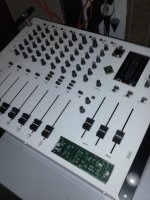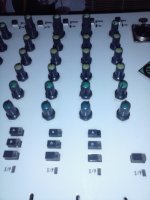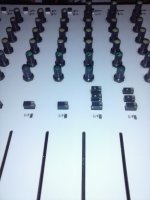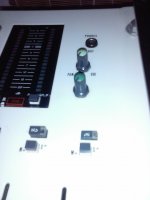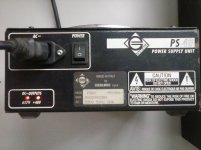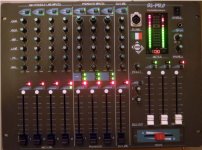Some images of Generalmusic DJ PRO II restoration
The attached image is that of a mixing console Generalmusic DJ PRO II with the original finish, which does not correspond to the situation in which I received my mixer. It is an image that circulates on the web, not taken by me, unlike the previous ones.
The attached image is that of a mixing console Generalmusic DJ PRO II with the original finish, which does not correspond to the situation in which I received my mixer. It is an image that circulates on the web, not taken by me, unlike the previous ones.
Attachments
Nice work
Probably because You mixer has RCA line inputs & not jacks.
That means, depending on how its' wired, You will short Phantom when You switch to Line.
Double check.
I would let the PSU 48V always on & install a switch on the mixer for the 48V.
Are You sure these XLR's are truly balanced ? I mean capsule between pin 2 & 3 work with no ground connection to pin 1?
Greetings from Santo Tirso
is not provided with something so simple.
Probably because You mixer has RCA line inputs & not jacks.
That means, depending on how its' wired, You will short Phantom when You switch to Line.
Double check.
I would let the PSU 48V always on & install a switch on the mixer for the 48V.
Are You sure these XLR's are truly balanced ? I mean capsule between pin 2 & 3 work with no ground connection to pin 1?
Greetings from Santo Tirso
Last edited:
Thanks, Maaco.
I realized that I could have that difficulty, if it were really possible to deal with the subject of phantom power. There is no problem with leaving the phantom power permanently on, but I will have to re-examine the configuration in the module’s input. I deduce that it is standard because all the microphones that I connected to this console had normal polarity and I never noticed any phase inversion.
I realized that I could have that difficulty, if it were really possible to deal with the subject of phantom power. There is no problem with leaving the phantom power permanently on, but I will have to re-examine the configuration in the module’s input. I deduce that it is standard because all the microphones that I connected to this console had normal polarity and I never noticed any phase inversion.
Do you recommend any type of switch in particular? I am always in doubt about this, since from day to day I perceive less reliability in miniature switches and since it is a “forever” console, I hate opening the console multiple times to change switches. I need a robust solution, although the console is not used primarily in the first line of work.
There will be only five switches and the console is for my personal service, so I don't mind investing in high quality switches.
There will be only five switches and the console is for my personal service, so I don't mind investing in high quality switches.
The question is where to find that solution with confidence and it is not exactly the field where I move best, unlike connectors.
Do you know of any place where i can buy switches that meet the robustness criterion I am referring to? What do you advise? Switches of any kind, plugs and cables are issues of the greatest importance to me.
Do you know of any place where i can buy switches that meet the robustness criterion I am referring to? What do you advise? Switches of any kind, plugs and cables are issues of the greatest importance to me.
You can't hear polarity inversion unless one of the speakers is inverted, perhaps using a scope to observe the waveform.ll the microphones that I connected to this console had normal polarity and I never noticed any phase inversion
If Your XLR pin 1 is tied to pin 3, (Balanced cheating) every dynamic mike works.
Pin1 is usually connected to the mike case and not to the capsule.
Usually You have only one for all channels or a few of them.There will be only five switches
Plenty to choose from. Look for rocker / toggle switches for lighting or similar.Do you recommend any type of switch in particular?
If You want to use one for each channel, use one of those small metallic ones similar to those used in old cars.
You can find them everywhere.
I don't like those small square push latch switches on consoles because they become intermittent after some time, and You can't find them easily.
Last edited:
Maaco:
Thank you for your comments about the various possibilities in the application of P48 in the microphone inputs of the Generalmusic DJ PRO II mixing console.
I do not want to appear lazy but given what I am perceiving in this area, it seems to me that the ideal would be to use only one switch and make P48 arrive at each of the roads, the type that you have indicated and with which I agree perfectly.
I don't like the small switches with the square key either. Toggle-type will be ideal.Exactly as you said.
I am taking a tour of the switching equipment at several suppliers and I see that many of the possible switches are not ready for service at voltages of 48 volts. I don't know if this is very important or not in this case. The total consumption is extremely low and all the switches I am examining are used for this, of course. In terms of service voltage, I am seeing little equipment (within the profile that would be ideal).
Thank you for your comments about the various possibilities in the application of P48 in the microphone inputs of the Generalmusic DJ PRO II mixing console.
I do not want to appear lazy but given what I am perceiving in this area, it seems to me that the ideal would be to use only one switch and make P48 arrive at each of the roads, the type that you have indicated and with which I agree perfectly.
I don't like the small switches with the square key either. Toggle-type will be ideal.Exactly as you said.
I am taking a tour of the switching equipment at several suppliers and I see that many of the possible switches are not ready for service at voltages of 48 volts. I don't know if this is very important or not in this case. The total consumption is extremely low and all the switches I am examining are used for this, of course. In terms of service voltage, I am seeing little equipment (within the profile that would be ideal).
However, it is only now that I started to see what exists and there will certainly be more alternatives to appear soon. For now, I would bet on Carling, both for switches per channel and for the general control option of the P48.
Toggle Switches | carlingtech.com
110/216-Series: Small, Shallow Base AC/DC Toggle Switch
Thank you very much for your attention.
Best Regards
Macedo Pinto
Portugal
Toggle Switches | carlingtech.com
110/216-Series: Small, Shallow Base AC/DC Toggle Switch
Thank you very much for your attention.
Best Regards
Macedo Pinto
Portugal
That's what's standard, but it's Your mixer. You decide.the ideal would be to use only one switch and make P48 arrive at each of the roads,
I would bet on Carling, both for switches
I'm sure the ones You find in electronic shops work fine for 48V. I've seen many tiny ones for switching 230V. We are talking at a few say 100 mA current for all the mikes. You don't need to spend much money on switches. Those 110/216 look nice but 12.70 mm mounting hole is perhaps too large. It would look nice on a guitar. I would go for 5-6mm diameter.
- Home
- Live Sound
- PA Systems
- LEM Mixer 518 Stereo - Service-Manual wanted
